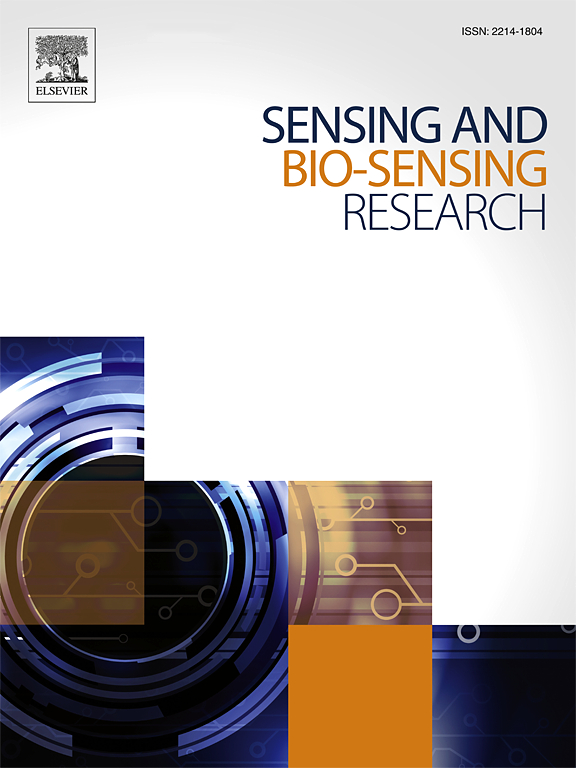Monitoring of lipid oxidation using a fluorescent sol-gel functionalized material
IF 4.9
Q1 CHEMISTRY, ANALYTICAL
引用次数: 0
Abstract
The food industry lacks rapid, easy-to-use and non-toxic analytical methods to assess the oxidation level of lipid-rich products. A new fluorescent sol-gel sensing material was developed for the fast and simple monitoring of carbonyls secondary products of lipid oxidation. This paper defines the sensor's range of applicability, specifically examining the impact of the nature and structure of the detected carbonyl compounds, as well as the effects of pH and the nature of the food-simulating medium on its response. The material exhibited high fluorescence intensity, which was quenched upon interaction with carbonyls. The size and hydrophobicity of the analyte (propanal, hexanal, nonanal, 1-penten-3-one and 1-octen-3-one) impacted the kinetics and the percentage of fluorescence quenching as well as the limit of detection and the saturation limit of the sensor. Additionally, the solvent nature had a significant impact on fluorescence: fluorescence intensity was higher in ethanol compared to the more polar ethanol/water (10/90, v/v) mixture used as a food simulant. Finally, the optimal pH range to operate the sensor was determined to be from 7 to 9. This study thus validated the feasibility of using this new sensor for the fast (less than 5 min) and simple (no sample preparation) monitoring of food oxidation level without using any toxic reagent compared to conventional methods. The sensor enables global carbonyl content determination within an operative pH range and a range of detection that would cover the entire shelf-life of lipid-rich food products.

利用荧光溶胶-凝胶功能化材料监测脂质氧化
食品工业缺乏快速、易用和无毒的分析方法来评估富含脂质的产品的氧化水平。为了快速、简便地监测脂质氧化羰基副产物,研制了一种新型荧光溶胶-凝胶传感材料。本文定义了传感器的适用范围,具体考察了被检测羰基化合物的性质和结构对传感器响应的影响,以及pH值和食物模拟介质性质对传感器响应的影响。该材料具有较高的荧光强度,荧光强度在与羰基相互作用时被猝灭。分析物的大小和疏水性(丙醛、己醛、壬醛、1-戊烯-3- 1和1-辛烯-3- 1)影响动力学和荧光猝灭百分比,以及传感器的检测限和饱和限。此外,溶剂性质对荧光有显著影响:与极性更强的乙醇/水(10/90,v/v)混合物作为食品模拟剂相比,乙醇中的荧光强度更高。最后确定传感器工作的最佳pH值范围为7 ~ 9。因此,与传统方法相比,本研究验证了使用这种新型传感器快速(不到5分钟)和简单(无需样品制备)监测食品氧化水平的可行性,而无需使用任何有毒试剂。该传感器能够在一个有效的pH范围内进行全球羰基含量测定,检测范围将覆盖富含油脂的食品的整个保质期。
本文章由计算机程序翻译,如有差异,请以英文原文为准。
求助全文
约1分钟内获得全文
求助全文
来源期刊

Sensing and Bio-Sensing Research
Engineering-Electrical and Electronic Engineering
CiteScore
10.70
自引率
3.80%
发文量
68
审稿时长
87 days
期刊介绍:
Sensing and Bio-Sensing Research is an open access journal dedicated to the research, design, development, and application of bio-sensing and sensing technologies. The editors will accept research papers, reviews, field trials, and validation studies that are of significant relevance. These submissions should describe new concepts, enhance understanding of the field, or offer insights into the practical application, manufacturing, and commercialization of bio-sensing and sensing technologies.
The journal covers a wide range of topics, including sensing principles and mechanisms, new materials development for transducers and recognition components, fabrication technology, and various types of sensors such as optical, electrochemical, mass-sensitive, gas, biosensors, and more. It also includes environmental, process control, and biomedical applications, signal processing, chemometrics, optoelectronic, mechanical, thermal, and magnetic sensors, as well as interface electronics. Additionally, it covers sensor systems and applications, µTAS (Micro Total Analysis Systems), development of solid-state devices for transducing physical signals, and analytical devices incorporating biological materials.
 求助内容:
求助内容: 应助结果提醒方式:
应助结果提醒方式:


